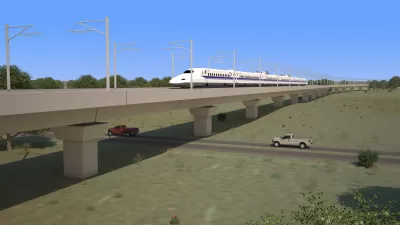A proposed Houston-to-Dallas rail line shows promise, but faces major hurdles before it can come to fruition.

The proposed Texas Central high-speed rail line linking Houston and Dallas, long considered a pipe dream by many rail advocates, is inching closer to reality, reports Joshua Fechter for Houston Public Media.
Amtrak officials consider the route ideal for high-speed rail. It would connect two of the country's largest metropolitan regions, which haven't had any form of passenger rail between them since Amtrak shuttered a Dallas-Houston route in 1995. And it would run through relatively flat land, allowing the train to reach top speeds and travelers to bypass congestion on Interstate 45.
Amtrak took the lead on the project in April. However, a lack of robust support for rail projects has been plaguing the proposal. In Dallas, city council members expressed concern that routing the train through downtown would conflict with redevelopment plans. “However, moving the line could delay the project's federal environmental approval up to a year, which the agency needs in order to begin planning and financing work.”
Ultimately, “Rail advocates acknowledge that expanding or adding passenger rail anywhere in the state will be costly and require substantial public investment.” Texas Central has acquired roughly 30 percent of the land needed for the project, but could still encounter opposition as it works to acquire the rest of the right-of-way.
FULL STORY: Texas is once more flirting with expanding passenger rail

Study: Maui’s Plan to Convert Vacation Rentals to Long-Term Housing Could Cause Nearly $1 Billion Economic Loss
The plan would reduce visitor accommodation by 25,% resulting in 1,900 jobs lost.

North Texas Transit Leaders Tout Benefits of TOD for Growing Region
At a summit focused on transit-oriented development, policymakers discussed how North Texas’ expanded light rail system can serve as a tool for economic growth.

Why Should We Subsidize Public Transportation?
Many public transit agencies face financial stress due to rising costs, declining fare revenue, and declining subsidies. Transit advocates must provide a strong business case for increasing public transit funding.

How to Make US Trains Faster
Changes to boarding platforms and a switch to electric trains could improve U.S. passenger rail service without the added cost of high-speed rail.

Columbia’s Revitalized ‘Loop’ Is a Hub for Local Entrepreneurs
A focus on small businesses is helping a commercial corridor in Columbia, Missouri thrive.

Invasive Insect Threatens Minnesota’s Ash Forests
The Emerald Ash Borer is a rapidly spreading invasive pest threatening Minnesota’s ash trees, and homeowners are encouraged to plant diverse replacement species, avoid moving ash firewood, and monitor for signs of infestation.
Urban Design for Planners 1: Software Tools
This six-course series explores essential urban design concepts using open source software and equips planners with the tools they need to participate fully in the urban design process.
Planning for Universal Design
Learn the tools for implementing Universal Design in planning regulations.
Ascent Environmental
Borough of Carlisle
Institute for Housing and Urban Development Studies (IHS)
City of Grandview
Harvard GSD Executive Education
Toledo-Lucas County Plan Commissions
Salt Lake City
NYU Wagner Graduate School of Public Service





























